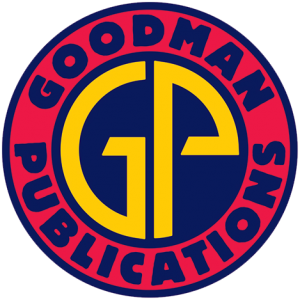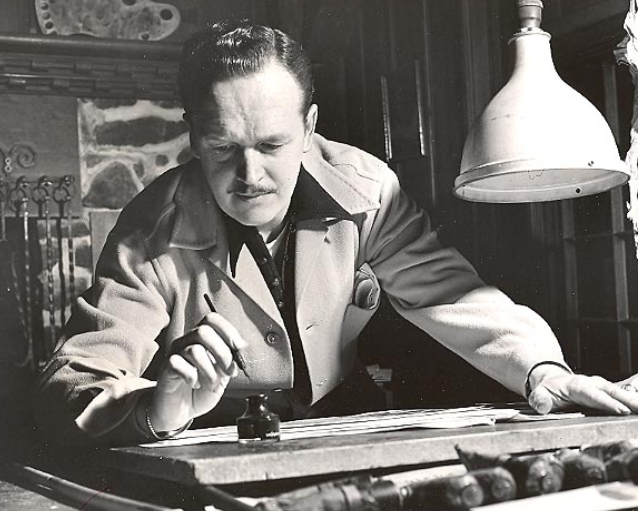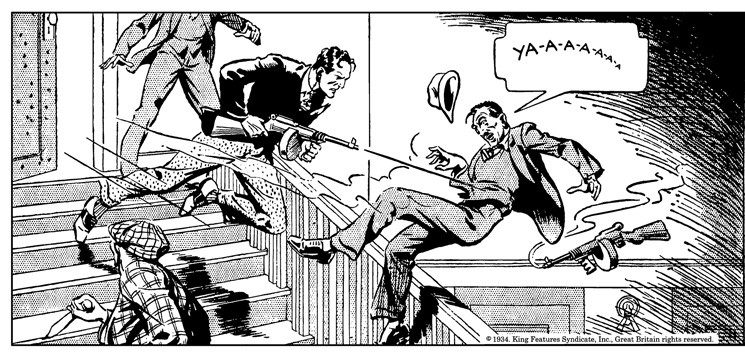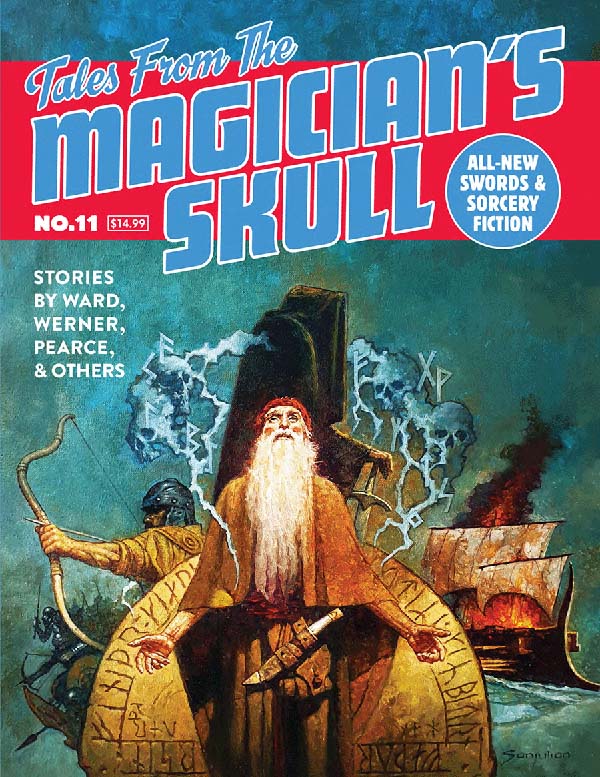A Profile of Alex Raymond
by Joshua LH Burnett
Few people have influenced American comics as much as Alex Raymond. While “Jungle Jim” and “Rip Carson” may not be household names, Raymond’s most famous creation, Flash Gordon, is so ingrained into American pop culture that simply his name can be used as shorthand for a specific type of heroic, romantic science fiction. Alex Raymond’s career was short, and his death came far too soon, but his art and influence are immortal.
Alexander Gillespie Raymond Jr was born in 1909 to Beatrice and Alexander Raymond in New Rochelle, NY. Alex’s father was a civil engineer, who supported his son’s artistic interests. Sadly, the elder Raymond died when his son was 12, and Alex Jr. decided against going into art as a career. Instead, Raymond went to Iona Preparatory School on an athletic scholarship and pursued a career in finance. He briefly worked in a brokerage office on Wall Street, but the financial crash of 1929 ended that career path. Returning to his earlier ambitions, Raymond enrolled in the Grand Central School of Art in New York City, a storied institution that would count artists such as Normal Rockwell, Charles Addams, and Bob Kane among its alumni.
In 1930, Raymond began to work with cartoonist Russ Westover, assisting him on the comic strip Tillie the Toiler. Through Westover, Raymond was introduced to King Features Syndicate, one of the largest comic syndication companies to this day. Raymond worked as a staff artist for King Features, assisting on such strips as Tim Tyler’s Luck and Blondie.
Raymond got his big break in 1933 with the comic strip Secret Agent X-9. This comic told the adventures of X-9, a nameless agent for a nameless government agency. The strip was created and written by legendary crime author Dashiell Hammett, who by this time had already written the Maltese Falcon and would soon go on to write The Thin Man. King Features assigned Raymond to do art for the strip, and the acclaim he got for X-9 would quickly set him up for the next step in his career.
In 1934, Raymond and ghostwriter Don Moore were assigned two more strips by King Features. These comics would be featured in the Sunday color comics page. Comic pages were bigger in the 30s, with much more space given to individual panels and strips than they are now. Certain large comics would run smaller strips (called “toppers”) above the main strip—two comics from the same artists in one space. Jungle Jim was one such topper. This adventure comic from Raymond and Moore told stories of explorer Jim Bradley and his adventures in the jungles of Asia. Jungle Jim ran above the comic that Raymond would become most famous for—Flash Gordon.
King Features wanted to create a comic to compete with John F. Dille’s popular Buck Rogers comic. King originally approached Edgar Rice Burroughs to discuss adapting his John Carter of Mars stories into comic form. While Burroughs was interested, he and the syndicate couldn’t come to an agreement. King Features instead tasked Raymond and Moore with creating an original science-fiction hero.
Flash Gordon featured the eponymous athletic hero Flash, his girlfriend Dale, the mysterious Dr. Zarkov and their adventures on the exotic planet Mongo ruled by the evil Emperor Ming. Moore’s sharp, exciting writing combined with Raymond’s lush, detailed illustrations would launch the strip to the heights of popularity, quickly outpacing their well-established rivals.
Raymond worked on Flash Gordon for the next 10 years. Over that time his technique and composition evolved. The panels grew larger, and while that meant there were fewer panels per strip, the larger area allowed Raymond to create more detailed and dynamic scenes. Raymond also began to forgo the use of word balloons, instead presenting dialog and narrative as text at the bottom of the panel. This allowed him to preserve his cinematic composition and sensual backgrounds without getting cluttered by comic ephemera. (This technique was also used in contemporary Hal Foster’s Prince Valiant strip).
Raymond left the comics industry in 1944 to join the U.S. Marines and fight in World War II. He was commissioned as a captain, and worked in public relations, creating patriotic recruitment posters and related art. He saw intense combat in 1945 serving aboard the USS Gilbert Islands in the Pacific theater. He was finally able to return to comics in 1946.
Raymond was not able to return to Flash Gordon. During his absence, the strip was continued by other artists, and King Features were unwilling to remove them from the comic. They did, however, give Raymond a chance to start a new comic. Launched in March of 1946, Rip Kirby was a daily strip that centered on J. Remington “Rip” Kirby, a former marine turned private detective. Unlike the hard-boiled and noirish exploits of X-9, Rip was a more relaxed intellectual sort of detective—bespectacled, pipe-smoking, and with a steady girlfriend. It is believed that Raymond wrote this strip himself. His is the lone credit, and if he had a ghostwriter, their name remains unknown.
For the Rip Kirby strip, Raymond’s style would change once more. While Flash Gordon and Jungle Jim were color, Sunday-only strips (Raymond never worked on the Flash Gordon dailies), Rip Kirby was a daily black and white strip. Lacking room for captioned dialog, he returned to using word balloons. And while the strips lack color, his dynamic inkwork lends tone and texture to the illustrations. The “Raymond Style” style went on to influence many of the soap opera style comic strips that became popular in the 50s and 60s.
Alex Raymond worked on Rip Kirby until his untimely death in 1956 at the age of 46. While driving a Corvette convertible owned by fellow cartoonist Stan Drake (The Heart of Juliet Jones), it began to rain. Rather than stop to put the top up, Raymond decided to drive faster to reach his destination quicker. While going twice the 25 mph speed limit, Raymond lost control of the car and hit a tree. Drake was thrown clear, but Raymond was killed instantly. Raymond had been in four car accidents in the month prior to his final one.
Alex Raymond’s style was—and remains—massively influential. His clean line-work, inked with a dry brush, features variable line-width which gives his work depth and texture. His men are square-jawed and athletic, his women are voluptuous and tantalizingly costumed, but all are realistically proportioned thanks, no doubt, to Raymond’s use of live models as reference. His comic panels vary in their size and position which help with pacing and impact. Raymond’s almost-exclusive use of medium and medium-long shots lets him highlight the characters’ dynamic poses, expressions, and clothing details without hiding his dreamlike backgrounds. His influence is seen in such legendary artists as Jack Kirby, John Romita Jr., and Joe Kubert. Alex Raymond helped define the classic American comic art style for decades to come.
Like Edgar Rice Burroughs, Raymond’s contributions to science-fiction and fantasy are so foundational that his influence (to say nothing of the influence of those influenced by him) in RPGs is easy to see. Of course, there have been dozens of science-fiction RPGs over the decades, almost all of which owe debt to Flash Gordon to one degree or another. While it remains a defining work for the space opera and planetary romance genres, Flash Gordon is more steeped in what modern readers might recognize as the tropes of heroic fantasy. Certainly, there are plenty of spaceships, but they serve mostly as transportation from exotic fantasy world to exotic fantasy world. On these fantastic planets, Flash is less likely to blast a bug-eyed alien with a ray gun than he is to fight a dinosaur with a sword. Dragons, giants, manticores—Raymond’s monsters are more often mythical as they are alien. Delving into a monster-haunted underground labyrinth, accompanied by a semi-human ally, to rescue a hostage from some terrible monster controlled by an evil warlord—this plot is as common in Flash Gordon as it is in any dungeon-based fantasy RPG.
Artistically, traces of Raymond’s style can be seen in early RPG illustrations. In the 70s and early 80s, the stylistic line between sci-fi and fantasy was not so clearly defined. The elaborate capes and headgear of Erol Otus or the high colors and tight tunics of Bill Willingham feel more like something from Mongo than Middle Earth. On a technical level, Raymond’s precise, dry-brush style is evident in the inked works of Larry Elmore and Jeff Easley. Allen Nunis—illustrator for Traveller, Torg, West End’s Star Wars, and many other games—cites Raymond as a major influence. (Star Wars, of course, also sprung from George Lucas’s desire to make a Flash Gordon movie.) Raymond’s influence also lives on in any illustration of a strapping hero with a sword protecting a bemidriffed princess.











